Here we review all the best garage floor paint on the market today in our view, with links to all you need for how to paint garage floors, including all the testing and prep you need. At the bottom of the post ( or in the right column on desktop), you see all the related concrete and garage floor paint posts in one place. You can also check our latest post on concrete paint.
If you just want our top picks here at the top…
See our top recommendation here for 2-part (“2-K”) epoxy product: GarageGuard from INSL-X (Benjamin Moore). This is a water-based semi-gloss coating proven to have outstanding properties. Hands-down the best garage floor epoxy coating on the DIY market today. We apply this very product to our customer’s garage floors.
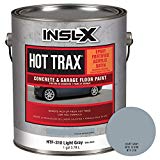 In the category of “1-K” (one-step) garage floor paint (it is paint with epoxy resin added), we have 3 recommendations below. But the best of the best: Benjamin is the winner once again with Hot-Trax from INSL-X. We chose this as the best of our top picks…but it’s a close race. All of the so-called “1-K Epoxy” is not a true epoxy: it is acrylic paint fortified with epoxy resin for toughness. Excellent, and applies like any paint.
In the category of “1-K” (one-step) garage floor paint (it is paint with epoxy resin added), we have 3 recommendations below. But the best of the best: Benjamin is the winner once again with Hot-Trax from INSL-X. We chose this as the best of our top picks…but it’s a close race. All of the so-called “1-K Epoxy” is not a true epoxy: it is acrylic paint fortified with epoxy resin for toughness. Excellent, and applies like any paint.
Jump to the full description below.
Garage Floor Coating: we will cover the following points
- Our Top Recommendations for garage floor coating (and Why We Don’t Skimp on Product Quality)
- The Reality of Doing this Project
- What the Other Website Reviews Get Wrong
- Why Coating a Garage Floor is a Good Idea
- Cost and Coverage
- Epoxy 101
- Prep and How to Paint Garage Floor Steps (links to these, plus texturing and more)
- Warnings – How to Avoid Mistakes
- Cleanup Made Easy
There are 2 basic types of garage floor coatings (not counting garage tiles and mats): 2-K and 1-K epoxy garage floor paint. The best prices we could find were online.
Here we are only going to present our recommendation of the best garage floor paint in each category and nothing else. Why? Because the last thing you want is to have paint problems on a concrete floor.
Other websites seem to push sales for their own benefit: we have no income or compensation from any paint or paint product maker.
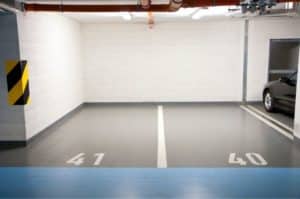
Today’s garage floor paints are so much better: the older paint chemistry did not give garage floor coatings the toughness they need—hot tires would pull it off.
Tires come in off the road (even from slow gravel roads) somewhat warm, and that combined with the enormous weight of the vehicle would in time, pull the garage floor paint up. That’s our problem.
Our recommendations come from experience and from our talks with other professional painters, some specializing in nothing but garage floor paint.
It’s not just our experience: we have done many hours of research into today’s market and we will continue to update this post.
Here is a list of the best garage floor paint (and other products) on the market today.
1. Our Top Recommendations (and Why We Don’t Skimp on Product Quality)
A note about coverage: When you see “400 ft²/gallon” think that this is for a fairly smooth concrete floor; rougher floors may get less. Every maker tests coverage differently.
Top Dog: Two-component epoxy paint (not really paint)
The best garage floor paint (not really ‘paint’) for your hard-earned money. No primer is required after proper prep, and you can drive on it in 3 days for cool tires, but you must wait 5-7 days for warm tires. (We tell our customers to park the wheels on cardboard for a month to be safe).
Typical 1-car garage is 14 x 22 = 308 ft²
Typical 2-car garage is 24 x 24 =576 ft²
What I suggest to my customers:
Our top product is GarageGuard from Benjamin Moore (INSL-X line).
-
- 2 colors, gray and sand
- Dry film thickness: 2.4 – 2.9 mil
- Coverage: about 250-300 sq. ft. per
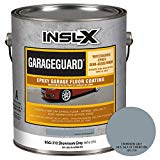 gallon
gallon - Interior only
- Semi-gloss sheen: easy cleaning.
- Recommended roller cover: ¼ to ½-inch (good to have one per gallon)
- Tack free in 2 hours
- Do second coat after 8 hrs, but best before 24 hours (some seller pages get this wrong – see TDS* below)
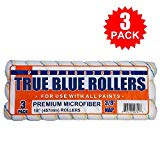
- If adding more coats, they must be applied inside 48 hours (at 77 °F): if you miss that window, you must sand the surface for proper bonding. Don’t forget to clean any new dust.
- Working life is 4 hours in normal room temperatures (read below about how “100%” epoxy floor coating can be as quick as ½ hr)
- Clean up: soap/water (we just use hot water)
Remember that after mixing the two cans, the product will become un-workable in 4 hours, so be ready to do the entire floor right away. We only open and mix one gallon at a time because we take breaks and have to answer the phone, check the playoffs, etc.
You should plan on 2 coats. In the epoxy discussion below, we explained why we prefer 2 coats of “50% solids” epoxy over one coat of the “100% solids”.
 Cost? Way less in the long run. It does cost a bit more than the hardware store kits you will see on TV and in the big home stores (more on Rustoleum’s concrete paint kits just below). GarageGuard is really not much more expensive than Ben Moore’s best interior paint, which we find amazing.
Cost? Way less in the long run. It does cost a bit more than the hardware store kits you will see on TV and in the big home stores (more on Rustoleum’s concrete paint kits just below). GarageGuard is really not much more expensive than Ben Moore’s best interior paint, which we find amazing.
INSL-X makes excellent paint that we use and you can too. GarageGuard uses amine adduct epoxy as its resin, which Benjamin Moore believes is superlative for garage floors. We are not saying that other forms of epoxy are bad: the lower cost of some paints (below) is certainly nice. But then there is the quality thing.
The cost is more, but so is its longevity. As in Section 5 on costs below, you need 2 gallons per coat of a typical 2-car garage (about 550 ft²). We would also do a 2nd coat so that brings your total to 4 gallons, a perfectly typical number. The bill is really not that much more than Ben Moore’s better paints such as Aura, which is not that much different in price per gallon! We feel this is a very good deal for this kind of quality.
* Here is the TDS (tech data sheet).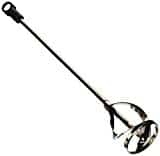
You will mix the paint with your drill on low speed. You’ll need the attachment shown: this is all explained in the post on the actual painting process.
Big tip: Never try to mix partial cans: the measured ratio is key to strength and longevity. GarageGuard is a medium health concern as is all 2-K epoxy, so wear protective gear like gloves, goggles, respirator, etc. Read the label carefully and follow directions to the letter: we do this.
Here is a boring GarageGuard video. It’s just sales, but makes the point of the ease of application.
Runner up:
Rust-oleum EpoxyShield Solvent-Based Garage Floor Paint
The only other DIY kit we like is Rust-Oleum’s EpoxyShield. We like it because it comes from a trustworthy maker. It’s also a bit less expensive. Slightly thicker than GarageGuard, it dries to a 3.5 to 5-mil thickness which is not bad at all.
But from our research, the resins and hardener combination in the GarageGuard above is better for the money.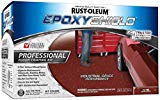
The solvent for this paint is xylene (or this substitute) You can also get methyl isobutyl ketone. Have this handy to get any drips immediately: clean mistakes as you go. You don’t need much xylene or go with a safe substitute: EcoSolvent. We link you to the Rus-Oleum pages that have:
The Rustoleum 2-K kits are marketed to homeowners and not pros. We have not personally used them, but we wanted to include them as they have a decent track record. They make different levels of this product, and the best is the Professional EpoxyShield line. Matching color flakes are included in the kit.
You’ll read some one-star reviews but these are mostly from people who did not read our page about preparing concrete floors for painting.
Other painters that we chat with have some negative remarks about it but they also admit they only use industrial coatings not marketed to homeowners.
The dried coating is thicker than some other DIY products, but we feel that this is not necessarily better. We have taken a dive into the deep end of epoxy chemistry and found that the sacrifices Rustoleum made to arrive at this result was made at the expense of other quality raw materials.
This is also why it costs less than our top pick above. This is merely an opinion.
Is it a good paint? Sure. If prepared well and applied well, it should hold up. It’s just not the Caddilac of the best garage floor coatings.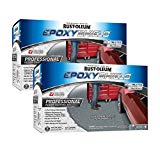
Kits are available in one-car (for ~300 ft²) and two-car garage (for ~550 ft²) sizes do if you have a 3-car you know what to do. There are 4 colors in the ‘professional’ line: One kit is one coat for the area it is intended to cover (so a 2-car garage would need two, 2-car kits). The photo link takes you to all four:
Dunes Tan Semi-Gloss
Silver Gray Semi-Gloss
Dark Gray Semi-Gloss
Tile Red Semi-Gloss
- Coverage: about 250-300 sq. ft. per gallon.
- Rustoleum claims one coat only needed, but we doubt that. We would do 2.
- Flammable: extinguish all pilot lights and do not smoke, Wille.
- Semi-gloss finish.
- Recommended roller cover: 3/8 inch synthetic roller cover.
- Our page with basic painting tools is here for the rest.
- Foot traffic in 16 hours.
- Vehicle traffic in 4 days.
- If adding more coats, they must be applied inside 48 hours (@77 °F): if not you must sand the surface for proper bonding. Don’t forget to clean any new dust.
- Working life is only 2 hours in normal room temperatures.
- Clean up is with xylene.
Mix with drill/paddle on low for 2 to 5 minutes, stirring occasionally during use until complete. Allow to stand 30 for the ‘induction period’, then start cutting the edges. Apply only between 55°F and 90°F with RH less than 85%. Use all the paint within 2 hours, then if needed, mix another batch.
Almost Famous:
Rustoleum’s RockSolid also gets a mention, but comes with 2 big warnings: working time and end results make this product less favorable (but we know many of you will be interested). 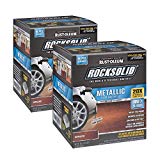
First warning: This is a “100% solids” epoxy and that means a short working time. Also, this product was created in 2014 to be easier to apply than, and to compete with industrial floor coatings that have the beautiful 3-D metallic swirl effect. They sell kits to work in small batches (1/2 of one-car garage per kit) to deal with this. So the price of a ‘kit’ may fool you: it is pricey. See more on “100%” vs. “50%” in Section 6 below.
Second warning: The metallic swirl look of RockSolid is not like you may thinking. Many professional painters get trained in how to drip solvent into the wet paints they special order, and work it to make the 3-D effect whereas RockSolid is mixed all in one ‘burst bag’…a video of this is here… like the cold ice packs for medics use for swelling. You cannot get the 3-D look with this product. And if you could, would you need the flakes spread on top? Not in our view.
Cost: Two “half- kits” (it would take 2 of these kits to do a 1-car garage), costs more than one 1-car garage kit of the EpoxyShield. To be clear, RockSolid is more than twice the price, but it does have more solids.
The working time (pot-life) of RockSolid is only 45 minutes per kit. You need to keep moving (and if you use the included flakes, that takes your pot-time up too).
It also comes in a “Pearlescent” which has some darker colors.
Then, in our research, we were turned off by the bad reviews: but to be fair all the delamination most bad reviews talk about are due to users not doing proper prep. But there were some others that just had the stuff flake off after some time and no abuse.
Half-kits? Be sure to look at the amount you are getting: some require 2 kits for a ONE car garage? What the? Yes. This shows that some people have a problem with the short working time: they keep the quantity small. This is another reason we like the big makers and avoid the DIY lines you see on TV.
They claim one coat will be enough. We cannot say, as we have not applied to this product yet and based on what we read in the painters’ chat rooms, we never will. I just can’t quit you, GarageGuard.
Here are all the best prices we found: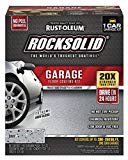
The non-metallic basic version: this page offers all 5 colors.
The metallic kits in ½-car quantities and several colors all on the same page.
The pearlescent option in 5 colors all on one page.
If you go this route, we highly recommend the small (one-car or ½-car) kits because you can mix in small sections so you don’t have to struggle to do an entire one-car area in the short working time. You may end up with a disaster with a 2-car or 2.5 car kit. You have the time. What do you have some hot date? You do? Cool. Have a candle-lit dinner on your new floor.
One-step epoxy paint (really paint with added epoxy)
While we do prefer the 2-K above, the 1-K paint is much simpler to deal with. In one case, we recommend 1-K over 2-K for garage floors that have a fair amount of vapor transmission. Moisture is the leading cause of floor failures after poor prep. Single components epoxies can have a higher tolerance for moisture permeance. The difference is the resins used in 1-K.
So if your floor is built on earth that stays wet, 1-K is a good way to go. Definitely research your floor and the paint at the same time. Read about the moisture testing of concrete.
Repeating from above:
Typical 1-car garage is 14 x 22 = 308 ft²
Typical 2-car garage is 24 x 24 =576 ft²The size of a 2-car garage varies so measure yours and remember the first coat takes a bit more than the 2nd.
We recommend three quality 1-K epoxy products:
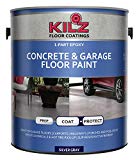 Our Top Pick is Kilz 1-K Garage Floor Paint, the lowest cost here at the top. The best in this class is yet to come.
Our Top Pick is Kilz 1-K Garage Floor Paint, the lowest cost here at the top. The best in this class is yet to come.
- Only 2 gray colors
- Coverage is 300-400 ft²/gallon
- Interior/exterior
- Recoat after 4 hrs.
- Primer not required
- Also for previously painted concrete
- Gloss is satin
- Requires 2 normal-thin coats
- Free shipping
- For concrete and all masonry
- Water to clean
Kilz claims that coverage can be higher (as much as 455 ft²) if you have a smoother-than-normal concrete floor or as low as 300 ft² for rougher floors. But you should not be painting a very smooth floor as we know from our post on how to prep concrete for painting.
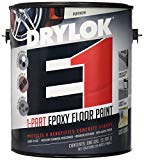 Drylok Concrete Floor Paint UGL’s E-1, for garage floors.
Drylok Concrete Floor Paint UGL’s E-1, for garage floors.
- 2 shades of gray
- Coverage is 300-400 ft ² for most surfaces
- Interior/exterior
- Cannot be applied over 2-K epoxy
- 4 hrs. to recoat
- Garage floor: 7 days without auto traffic
- Very low VOC
- Primer not needed
- Semi-gloss
- Apply in 2 normal to thin coats: no more than 2
- Free shipping
- Concrete only: not for other types of masonry
- Water cleans
Drylok concrete floor paint is often out of stock.
 Hot-Trax from INSL-X (Benjamin Moore) Of our 3 recommendations this is the best of the 3 in this class, but it’s a close race.
Hot-Trax from INSL-X (Benjamin Moore) Of our 3 recommendations this is the best of the 3 in this class, but it’s a close race.
-
- 2 shades of gray
- Coverage: 300-400 ft.²/gal for average surfaces
- Interior/exterior
- Wait for 24 hrs. for 2nd coat
- Do not walk on new paint for 48 hrs.
- Vehicles: wait 5-7 days
- Low VOC
- Never paint in direct sunlight or window sun
- Primer not needed
- Satin gloss
- Do 2 normal – thin coats
- If you buy 2 gallons, shipping is free
- For all masonry (concrete, stone, bricks, cinder block, etc)
- Water to clean
This is the best of its class and as easy to apply as any paint.
If you have concerns about hot-tire pickup, we link to some cool parking mats in Section 8 below.
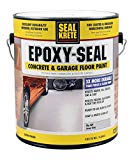 Seal Krete Epoxy Seal is a final worthy product and the cost is in the same range as Kilz above. This beats the heck out of Lowes garage floor paint section it costs one dollar more, but does Lowes deliver for free? It’s such a good deal to have paint delivered these days: amazing.
Seal Krete Epoxy Seal is a final worthy product and the cost is in the same range as Kilz above. This beats the heck out of Lowes garage floor paint section it costs one dollar more, but does Lowes deliver for free? It’s such a good deal to have paint delivered these days: amazing.
We have been asked about the Behr garage floor paint, containing no epoxy resins. Painters, in general, avoid home-owner lines of paint (all Behr) and so should you. Please don’t trust the TV ads or the online reviews: you cannot go wrong with the best concrete paint we recommend here when you prep correctly. (Video on delivery locker pickups: cool). Sure you already know where to get the Home Depot porch paint, but please think about the long term savings of using the best concrete paint.
2. Reality: Is this a DIY project?
If you have some painting experience, yes. If you have ever mixed epoxy glue, you can understand the 2-K epoxy “paint” (not really paint), and the other paints are, well, paint. If you are reading along and it all seems like too much, we have a section below on a great garage floor system: interlocking tiles.
Every garage floor product on this page is homeowner-do-able. Here, we do not recommend the trendy “100% solids” epoxy floor paint unless you have lots of experience: we would recommend that you leave that to a professional Why?
The pot-life of “100% solids” is short and if not applied properly, it can turn your project into a mess. One mistake and you will have to scrape and grind it off to get back to square one. Not fun.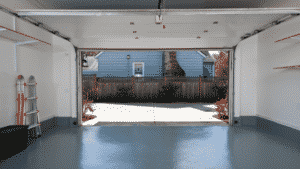
Two coats of 50% solids is a much better option (we do it professionally). But is the industrial version (100% solids) better? Yes, the stuff the pros get (not the Rustoleum above), it’s only one coat, and it’s faster. But it’s not that much better for the hassle. More on 100% vs. 50% in Section 6 below.
Some garage floors cannot be painted. This is about water and alkalinity. Most problems can be solved and then you can apply the best garage floor coating you can get. There’s more on this on the concrete floor prep page, but to condense it: you should test your slab. We highly recommend that you do two water tests at least; and if you have concerns, also the alkalinity test. (Most garage floors don’t have an alkalinity problem).
3. What the other garage floor paint reviews get wrong
We’ve been reading some other ‘garage floor paint’ websites and posts. They are saying all concrete needs to be ‘profiled’ i.e. roughed up. Yes and no. All floors must have a profile (roughness) of about 100-80 grit sandpaper, but many floors are created like that. All most floors need is the complete cleaning and rinsing and drying. But some concrete is trowled very smooth, and then yes you need to etch. Here is all about that.
Following a lot of research into the best paint for a garage floor, we have settled on the above that should suit any budget. Other websites want you to buy their paint and mention 2-part epoxy just as a side note. They say how expensive epoxy is. Not true in the long run. The upfront cost is a long-term saving.
We read some websites saying that if you want to save money, then low-budget paint may be the thing for you. Hogwash. They claim latex acrylic paint is a good choice because you have many choices in color. Are 5 choices not enough? For a garage floor? Do you need a Chartreuse? We think too many choices is bunk.
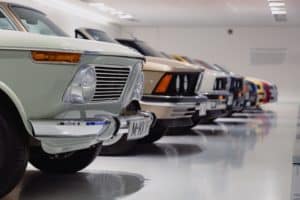
Latex paint is not appropriate for a garage floor coating, although some may be formulated to be tougher: they will not last like our recommendations of the real deal 2-K epoxy or even the 1-K. Period.
We do not recommend you use any garage floor paint without epoxy resin unless you will park on the bumper mats (linked in Section 8 below). These are nice because your car is always in exactly the same spot. One customer had us use normal cement paint and used these mats. He’s happy. (We have all our concrete paints on one page.)
But even if your car does not stand on this cement paint, you still have to drive on it to come in and out of the garage…and it’s probably not going to last very long. We never tried. Why would we when for a few dollars more… you see where this is going.
Labor. Oh, labor. Get the best garage floor coating to start with and you will not have to buy more in a few years, then do it all over again in another few years. Plus, in between re-paints and touch-ups, your floor is chipping and peeling and you have big gaps where your tires land from even mild tire heat.
Sales, oh sales. Many websites are recommending clear coating over your epoxy: we don’t like this idea and we explain why in Section 6 below.
4. Why garage floor paint is a good idea
The good news is that if done right the best garage floor paint will last decades and more. But you must do the prep well. We hear stories about floors done 10 years ago and they are still looking great. The best garage paint can do so much:

- Can hide eyesores like cracks and stains
- Eliminate the dust that bare concrete floors produce (important for automobile repair)
- Selling? Realtors we work with want the garage floor paint. The investment brings returns. This is a relatively inexpensive way to add some class (and hide stains!)
- Protection against mold and mildew
- Easier to keep clean
Rolling tool boxes, dropping tools, car jacks, welding slag, and so on: you have to expect some damage in spots and be prepared to touch up the coating when needed. Or not. It’s a garage.
Longevity:
One reader says that because he got the best garage floor paint on the market at the time (and the chemistry has only gotten better), his garage floor looks great after 10 years.
5. Cost and Coverage
For all these projections we used a typical 24 x 24 two-car garage. (576 sq. ft). Many 2-car garages are only 400 ft² (20 x 20). The size of a 2-car garage varies so measure yours: our numbers are just for comparison.
(Single car garages are normally about 14 x 22, or 308 sq. ft.)
You will use more paint/coating on the first coat (little grooves swallow paint) so if your math comes out close, we recommend buying a little more. Why?
Because if you need a 2nd coat, and most times we do, it’s best to re-coat within the time window specified on the can. If you go over, you’ll have to sand or prep as the maker specifies. Drag.
Also, when a paint maker tells you one gallon will cover XYZ square feet, they tested on a floor that is different from another maker’s test floor. Rougher floors take more paint per foot.
Our math here is based just on what they publish: we did not test all of these.

Costs:
Typical costs for 2-part epoxy paint is about 90-120 bucks per gallon.
Typical costs for 1-part epoxy paint is around 35-55 bucks per gallon.
Coverage:
2-K Epoxy: 250-300 sq. ft. per gallon
1-K Paint: 300-400 sq. ft. per gallon
Plan on two coats.
So there is the math ‘word problem’ for today. Below are a typical garage with our top picks as examples:
Your 2-car garage is 576.
GarageGuard covers 250-300 so you need 2 kits per coat, and 2 coats making 4 x 90 bucks =360 dollars. Worth it in my view.
Rustoleum EpoxyShield is 276, two coats. Not that much less than GarageGuard!
HotTrax is 43 bucks for 3-400 sq. ft. Lower price and better quality than Dryloc! Two gallons for our test garage makes 86.
Drylok is 56 for 3-400 sq. ft. Three gallons for our test garage equals 168.
Kilz is 33 for 4-500 sq. ft. so clearly the lowest price, and the best choice if you are using the parking mats linked below (Section 8). For our test garage, only 99 bucks plus the mats. Nice.
6. Epoxy 101
We went down the rabbit hole with a few paint company reps learning all about the chemistry of epoxy, but to be able to understand it would take a college degree in inorganic chemistry.
The bottom line is that the big-name makers spent the money to do the research and formulated the best garage floor paint on the market. You can spend less, but you have to think forward. We never want to hear that an epoxy floor we installed is cracking, so we don’t use the concrete floor paint or cement paint you see in TV ads.
“Epoxy” refers to many polymer groups, and which one is used determines the type of hardener used as either a reactant or as a catalyst.
Hands Down, The Best Garage Floor Paint is 2-K (two-component epoxy):
Why is even the garage floor epoxy paint not really paint? These do not air-dry alone. They actually give off heat as the chemical reaction hardens the mix, and they can be laid on very thick.
Epoxy has one part epoxy resin and one part co-reactant (hardener) that that initiates curing (reacts) to the epoxy. These hardeners can be very toxic, so read on about the respirators we use: surprisingly affordable. Good for the coming zombie apocalypse.
100% and 50% Solids:
In a 50% solids product, half of the product (the liquid carriers) will evaporate, and you are left with half the thickness of the film that was applied. That is not a bad thing.
The trend today is towards “100% Solids” that go on thick and to not evaporate: they stay as thick as applied.
Professionally, we prefer the 50% solids as do most painters who do not specialize in epoxy paints.
If you do want the “100% solids” floor coatings, get a painter who specialized in this best garage floor paint install it for you. Even we avoid them. Two coats of the GarageGuard (which is 50% solids) is exactly the same result (thickness) as the 100.
Garage Guard is an amine adduct epoxy, considered the best by Mr. Moore.
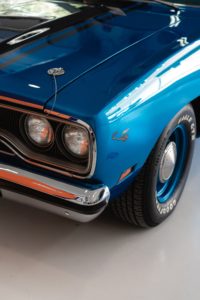
Pot-life:
Insert your favorite Willie Nelson joke here!
As soon as you mix the part-A resin with the part-B hardener, the clock starts ticking as the epoxy begins its curing process and must be applied to the floor before the working time runs out. There can also be a wait time (“induction time”) before you start the application.
Some epoxy paints have a very short pot life. For some ‘100%-ers’ it’s ½ hour. After that time, the liquid may seem fine after the time’s up. While it may appear to be unchanged, it won’t live as long when cured.
You will see some garage floor paint sites discussing other terms such as gel time and working life. They really are not important for us, the painters. There is not much difference between ‘working time’ and ‘pot-life’. Pot life is the time the viscosity doubles and working life is another way to say time’s up.
How to handle the product you choose will be fully described on your paint can label. Take it seriously.
The Runner up to the Best Garage Floor Paint is One-Component Epoxy (it’s not really epoxy).
There is no such thing as a true epoxy in one-step by definition of the word epoxy*. These are acrylic paints with some epoxy resins mixed in, and yes you can expect better durability for only a slightly higher price tag.
* …a class of reactive prepolymers and polymers which contain epoxide groups…(Wikipedia).
Ester resins in 1-K:
There are quite a few companies making 1-K paint, and before you pull the trigger on pick your epoxy paint, just make sure that the resin added is not ‘ester resin’ which is used by some, but is considered by experts to be unsuitable for garage floors. All the ones on this page are not esters.
The Good: As we mentioned in the 1-K paints above, the properties of the epoxy ester resin helps to provide for a paint that is more resistant to mold and mildew, chemicals, gasoline stains, oil, scuff marks, and chipping. So it’s not all bad.
The Bad: Ester resins are NOT suitable for 2-K garage floor paints.
The Ugly:
Ester resins are promoted for being able to withstand corrosion…but…
-
-
- become brittle over the years
- don’t stand up to garage floor normal use
- bad on any surface in unheated areas (prone to crack)
-
Why we don’t recommend clear coating over garage floor paint:

We explained why we don’t like them, but we know many people do.
Generally, these paints are not designed to be covered with a clear-coat, even though it is a possibility. But some top coats could soften the basecoat, which is designed to handle all that a garage can throw at it anyway.
Sales websites want you to buy a clear coat (it’s pricey too), but the best garage floor paint in 1-K or even 2-K paints do not require and are generally not formulated for a clear coat on top.
Polyurethanes used in most clear coats are typically for wood and do not have a formal relationship with epoxies. There are other types of urethanes used in the industrial maintenance field though they would be overkill for homeowner applications.
There could be incompatibility if the clear coat is more “chemically hot” which could cause lifting. Then you are starting over, just like John and Yoko.
Then there is the future. We feel it’s best to stick with one product instead of layering different products: again, this is in general. It’s our opinion.
Benjamin Moore agrees. They told us in an interview that they don’t recommend any garage floor paint be coated with a clear top-coat as things will be more difficult in the future. Thanks Ben.

If you have a new car showroom that’s different.
Safety:
Fumes of epoxy paints are toxic. Fumes can cause inflammation of the lungs and even death.
Wear a respirator and protect your skin. We untangled the crazy world of types of respirator filters and masks: it’s not at all expensive to have a good one.
Add to your list:
-
-
- Respirator, gloves, and goggles
- good ventilation: even in winter
- a fan and heaters really help
-
7. Painting Garage Floor and Prep Links
-
-
- PREP OF GARAGE FLOORS: For simplicity, we made a separate page just for prep: Concrete Floor Preparation List
This post contains info on the floor profile you need, plus moisture and pH, cracks, primers, cleaning, and curing. - PAINTING GARAGE FLOOR: A post on the sequence to follow to paint a garage floor, a complete step-by-step: Painting a concrete floor: full list. It’s more than just cutting and rolling.
- Gather the necessities: Safety glasses, nitrile or rubber gloves, respirator. I give people the knee pads you see here as a gift. Oh yes, I do. Great for cleaning the house too!
- PREP OF GARAGE FLOORS: For simplicity, we made a separate page just for prep: Concrete Floor Preparation List
-
But first…some tips for epoxy fans and then…
tips for all garage floor paint work:
Special Epoxy Painting Tips:
-
-
- Mixing: The people that wrote instructions for painting garage floors really mean it when they wrote that you should mix with a drill and paddle mixer on low speed. Mix too fast and air bubbles will be introduced and will not pop: they are forever, compromising the strength of the epoxy coating.
- Also, mix it for the amount of mixing time in the instructions: this is, of course, pivotal to the epoxy curing to the proper hardness.
- Temperature warnings: Read the label and stay within the boundaries: they tested what happens outside them! Most 2-K’s are meant to be applied above 50-55°F. This allows for a good reaction and prevents some of the problems listed just below.
- Humidity: Most 2-K’s are meant to be applied below 85% RH. Check your weather app!
- The best garage floor paint is 2-K epoxy which has a wait time before you should start painting: the “induction time”. What we call the “sweat-in” time, allows the chemical reaction to complete. Read the label carefully. If you apply too soon, you may have problems such as ‘blushing’, yellowing, lower-gloss than expected, reduced resistance to chemical spills, and a softer end result. The first sections you do will have a different color too: the later sections got the proper induction time!
- The clock is ticking once you mix: check your watch. Ok, let’s be honest, check your phone. But if you only mix one gallon at a time, you should not have any worries that you will not be finished applying it within the workability life of the mix.
- Tip: keep your phone in a plastic baggie while painting. Thank me later.
- If the paint starts to become stringy, you need to discard that and mix a new batch. After the clock says the time is up, even if the paint looks and feels fine, discard it and mix it again.
- A 2-K product usually has the ratio of 3:1 (these are pre-measured, you cannot use part of a can: combine it all and if you do not use it, that’s the brakes).
-
All Garage Floor Painting Tips:
-
-
- Buy more than you need if the measurements are close. If you have a garage floor that’s let’s say 400 sq. ft, and you buy exactly enough floor epoxy or paint for 450 sq ft. you still may not have enough. The profile (roughness) of every floor is different so makers don’t really know how far their stuff will go. Then there is the amount left in your roller and brush at the end of the job to consider. Use this tool as to squeegee every drip out (and to scrape paint, putty wall holes, etc).
- Also concrete when properly prepped will actually absorb some of the liquid into the slab, and you may run out. Many garage floor paints have a maximum time in which you can re-coat if you want multiple coats. If you have to order more paint, you’ll need to go through the sanding and cleaning steps that you would for any pre-painted floor.Total bummer, Keanu.
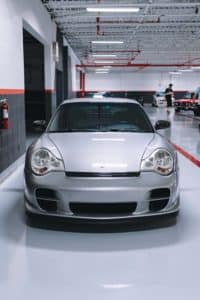
Perfectly painted garage floor in an auto shop - Don’t be tempted to apply the coating too thick or too thin: buy more than you think you might need: you usually will. Unmixed kits can be stored for a very long time.
- It’s a good idea to use masking tape with paper or plastic attached at the opening of your garage floor: this stuff can have a mind of its own! This is mentioned in the post on how to prepare concrete.
- Check the re-application time if you want to do a second or even third coat. We recommend more than one as the time will never come again that the floor will be so clean and easy to paint, and the extra coats build the thickness of the film which means a long life.
- Sprayer? Normally, for very large floors, sure go ahead and spray, but you should know that painting a floor is the easiest thing we painters do. Thank you gravity. You don’t need a pan or tray/bucket because you can just pour the paint/epoxy into a small puddle and dip your roller or brush in that. Trust us: it goes very fast. Here is our favorite sprayer for the home-owner or DIY-er. Read about all my favorite sprayers.
-
Remember:
While the new floor is curing, avoid all types of traffic, including foot traffic. This can result in paint being marked or torn, etc., which will require re-coating in spots. Read the label about curing times, not just for you epoxy users. If you cannot find that info, assume 48-72 hours for all paints and epoxies (in normal climates). If unsure, and only if necessary, corrugated cardboard in several layers can be used as stepping stones, to spread the force over a large area. Plywood on top of the cardboard is even better. In short: don’t park on it until it’s fully cured. You don’t want to re-do even though now you know how easy it is to paint garage floor.
Texturing and Camouflage Flakes
Color Chip Flakes:
You can apply color paint chips: they do look nice, but they also hide imperfections (like cracks). But then again, we like Pollack.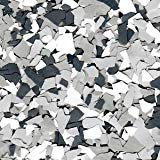
To get the flakes to spread evenly, throw small handfuls up in the air and really flick your wrist to spread it. Start slowly and you will get the hang of it.
Generally, after ‘broadcasting’ or tossing the chips, you would want a clear coating over that, but it’s not essential. Some recommend that you can keep adding the chips to the point of refusal (where no more stick), or just a light sprinkle which is more common. If you go to the point of refusal, many chips will be stuck up, like Russell Crowe, and will break off and need to be removed for months, like Russell Crowe.
We don’t recommend the ‘point of refusal’ flakes. Dragging a heavy table, for example, will tend to crack any chips not laying perfectly flat.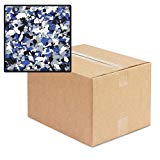
We recommend the chips made of epoxy but the acrylic will be fine too, even if you are doing the above ‘refusal’ method.
Maybe the best value for a standard home garage is the 5 lbs. of epoxy chips you see here that are much tougher than the acrylic chips. Many colors to choose from.
A very large bag of epoxy flakes (click on the cardboard box) if you have a big floor or need a lot to go to the point of ‘refusal’.
Rust-Oleum Flakes: Comes in various colors as well.
Benjamin Moore’s INSL-X has its own color-coordinated flake colors which has 3 very nice tones to choose from.
Texturing Sand:
Especially useful on steps that get wet, as well as on basements and garage floor paint. People like them in porch paint, patio decks as well as garage floor paint too.
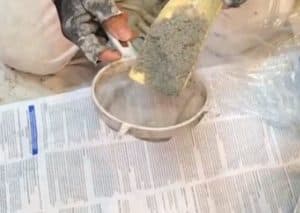
Main Tip Here: Don’t pour the sand into the paint tray/bucket. It all sinks, like my heart when I discovered that the first time! After you ‘broadcast’ the particles, roll/brush over them, that’s a must. Ba-da-boom.
Make sand: You can sift your own beach or garden sand or buy texturing in a bag. In this video we explain how we make our own fine and uniform sand: you don’t want larger sand grains in any floor paint (tell that to some of the big “old house DIY” websites: they use sand. Fail.)
If you don’t want to do it yourself, there are 2 other ways. Try fine silica already sifted. A pound can do a 2-car garage or what you can do with 4-5 gallons of paint.
The other option is small rubber particles. Use these anywhere you would normal texturing.
Paint a square, toss, and then roll it again to cover the particles. Your roller cover will never be ok for walls after that…just sayin’.
8. Some Warnings
We have looked at some website’s customer feedback of garage floor paint products’ failures. These reviews often blame the product, but when you don’t have a great deal of experience in painting, you simply cannot know that you might make a mistake. Mistakes are usually made in the prep phase. True, some makers do not use the quality of the best garage floor paints we recommend here. 
Fading
Even the best garage floor paint, when exposed to UV sunlight for a long time, some epoxy paint will fade or ‘amber’. So that will happen if you leave your big door open all the time or if you have sunny windows.
Most ordinary glass is a natural UVB filter, but the UVA is blocked only 25% by most window glass.
You can buy static cling window film (shown here) that blocks a lot more, and it can be tinted or totally clear. That cuts your energy bill too. Blocks 85% of infrared heat and UV 99% in summer.
Epoxy kits: some bad reviews
If you follow the directions properly you will probably be satisfied for some time. Just stay away from the lesser-known brands.
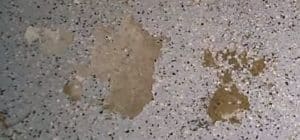
Some big store brand paint is in a lower chemistry class than the quality garage floor paint and epoxy coatings of the big boys. From our readings, the amine adduct epoxy in GarageGuard holds up the best in testing, but other formulas certainly can work as well.
For my 3 decades of painting, Ben Moore has always been the top brand and I always tell my customers that I prefer it.
Consider the risk of having the product not adhere, de-laminate, bubble, etc., and then having to remove it. What a nightmare. As always, we say spend a little more upfront: avoid headaches. No scraping off gooey epoxy that did not cure, etc., etc.
Final note: Long-term exposure to some brake fluid may fade coloring (but not affect the integrity of the coating in the case of GarageGuard).
Toxicity
We looked into what components of epoxy paint have been found to, or are known to cause cancer. Most paint companies keep these out of DIY products and that goes for Benjamin Moore too, but industrial coatings seem to just slap a warning on the label and buyer beware. Painter beware.
The good news is that once the epoxy/hardener reaction is over, all toxicity dangers have passed.
Please take our advice here: we wear respirators even with “low-VOC” interior paints you know where this is going.
If you properly wear a quality respirator, with chemical filters, along with skin and eye protection, you likely not be exposed to any harmful products. We cannot say this with 100% certainty because we can’t see you! Paint makers go to lengths to make their products safe but let’s not trust them.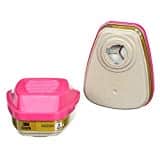
The mask we use: The 6200 is a medium for most women and the 6300 is large for most men.
The filters we use: 3M’s Multi-Gas/Vapor filters also have a HEPA outer filter to keep dust out of the main chemical filter.
Hot Tires ruin (non-epoxy) concrete floor paints
Even if you live down a long, slow gravel road, your tires come in warm.
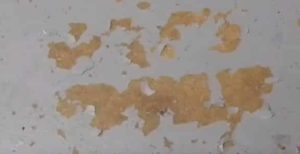
As the tire cools, the contraction of the rubber pulls the paint with it. The warm tire can soften garage floor paint. According to CarandDriver.com, tire temp. can rise 50°F after ½ hour at highway speeds, and it goes up more in the summer than it does in the winter.
In this review of garage floor paint, we picked only coatings and paints designed for garage floors and all resist hot tire pick up.
The TV-advertised epoxy paint kits (big stores) are generally the culprits. We have great feedback from the best garage floor paints that we are recommending above.
Tire Staining
Another problem with garage floor paints is the discoloring of paint from tires. This is due to plasticizer migration. Plasticizers are flexing agents in tires. Unfortunately, there are so many plasticizers in tires that it’s impossible for any paint manufacturer to claim that it can’t happen to their product. But remember, it’s a garage floor, so, just sayin’.
Perhaps the lowest cost way to go:
Hot-tire pickup can be eliminated if you park your car in the same spot every time bumper mats. Of course, you can also use a thick mat or old carpet. Then you can use any type of traditional cement paint that you like. You get added benefits:
9. Cleanup
When using 2-K epoxy paint, all tools and equipment should be cleaned before the system gels. Know your solvent and have it ready with several rags: your paint can label will tell you which solvent to use under the Clean-up section.
We have posts with videos on how to clean brushes and another on how to clean rollers: it’s not as bad as you think if you had some paint clean-up trauma when you were 19.
Feel free to leave a comment. Are there any garage floor paints that you have used that we have not recommended here? Please let us know!
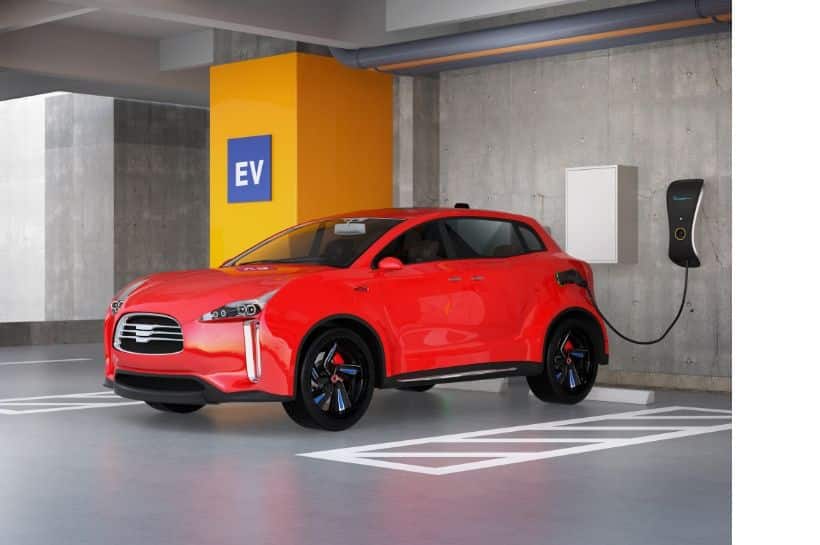
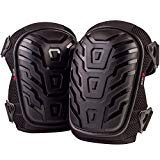
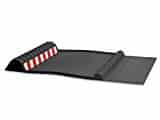
Hello! Is it possible to paint cement that has been sealed with tung oil? The oil was applied at least two years ago. I really love this site and would appreciate your advice!
Hello. I would be very careful here as the oil will have penetrated and dried, and it will be difficult for anything on top of it to bond. If I was going to try it myself, I would buy a small portion of Benjamin Moore STIX. I would apply that on a cleaned section in a discrete area of the floor. I would let it dry and then I would see if it bonded. How? By scraping. I don’t know of another bonding primer that is as good as this one but if you find others you might try it. If it does not bond, you could try a shellac based primer like a BIN. I do not mean the synthetic shellac primers. They are water-based. I mean the stuff that requires alcohol as a solvent. It’s very sticky and nasty to work with but maybe equal in bonding strength to Stix Good luck.
Hi Brad,
Appreciate all your articles and answering my comments/questions. I mentioned in the “concrete cleaners” article that our garage has a fragrant smell that we are trying to get rid of. Is there any way to seal in the smell, aside from putting in epoxy garage floors? Can we just use a masonry primer that you recommended in another article – Benjamin Moore Ultra Spec Acrylic Masonry Sealer – to seal in the smell and leave it as such without painting over it?
Thanks!
No, I don’t think that primer has any real odor blocking power. In fact it may just slow the off gassing process of the smell. To block it is going to be hard. Did you see my last reply? I was thinking my best advice was there: grind it down and then seal. You can rent a grinder, but it’s better to leave it to the pros. Again, ask the last owner what the heck they did to you!
That seems very important. If you approach it gently they may be helpful. If you express anger, they will clam up.
I have an stain and odor blockng paint post on this site, but it’s not for floors.
I put in a message to my guy at Ben moore. More later.
b
Hello Brad,
I’m so happy that I stumbled into this site. I certainly appreciate the tips and ideas.
Question for you:
I’m planning on putting epoxy on my garage floor. Most likely I will be using rust oleum professional. The first one on your list. I have intermittent moisture issues. Is this going to be a problem even if I apply on a dry day? And what happens if it gets wet before it’s completely cured?
Thanks Brad!
Hi. Well it dries so fast, just pick a time with no rain/fog coming. It’s always a crapshoot.
But your problem will really be if the cement is moist. That’s not good. You’ll be in for a world of hurt.
So pick up a moisture meter and/or put a portable heater in your garage on a hot day and do it when it’s at maximum warmth.
I can’t see it so I can’t tell. If in doubt, call a company that does epoxy floors. They can test your moisture probably for free.
Good luck
Brad, I appreciate it
Very comprehensive and excellent article and information.
Am I correct that I can use your preferred and recommended INSL-X product for an Exterior concrete balcony with a roof. It is covered on three sides with a iron railing (my condo). It is on the fourth (top floor). There are no windows or glass on or above the iron railings facing the outside open view outside environment. It is the original concrete (2005) never painted. The surface mild rough no oil or gas or grease that I know of. Balcony is 120 square feet.
Or is another product preferable.
Thank you very much
Yes and no. There are two INSLx products, one is for interiors only. I think all the other paints on this page…not sure… are interior/exterior. So yes on them.
Even tho you say there’s no grease, still, wash with a lot of scrubbing if you can’t pressure wash. The paint needs to bond and all that outdoor micro dust will prevent it’s best work.
Seal the can well for touchups every spring. That’s the easiest way to maintain it. For the first few years, it won’t even crack. Depends on the sun exposure and your latitude.
Good luck,
B
This is a great website! I have a couple questions (even though I’ve read pretty thoroughly) How do I determine if I need to scuff sand my garage floor? The old paint has anti-skid additive in it. It looks like the current paint is the first paint ever put on the floor. Can I use anti-skid additive in the INSL-X HOT TRAX? It’s very important that the garage floor is not slick.
I see. That’s difficult for me to answer because I cannot have a close look. If the floor is oil or even if it is a glossy latex, you should sand. That would mean sanding off the additive that grabs your shoes for traction… A big mess and a a big job,.
The test for oil or latex is here.
But if it is not oil or glossy, I think you can just clean and paint. I’d do a sample area first to test adhesion. Since Hot Trax is not a 2K epoxy, you can open the can, remove a 1/2 cup or whatever, and close the can with no bad effect. Then apply the paint in a corner and let it cure. That takes time. When really cured see how hard it is to remove, scratch or scrape off.
Yes, you can add silica as I described above. Test that at the same time you test the adhesion.
I hope this helps.
b
THANK YOU, Brad! This article is written with great care and completeness to detail. Your knowledge and experience is appreciated.